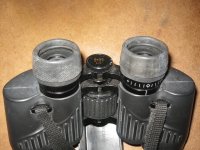Bloodstriker
Well-known member
Since joining this site to research my first binocular purchase, I now own a small collection of bins. There's just something about optics that I like.
I have noticed one consistent complaint though. It seems as if the eye relief of every single binocular I won is too much. Another way of saying this is that the eye cups are too short.
I wear contact lenses, so I need the eye cups extended on all my bins. It seems the only bins that I can brace easily is the Conquest HD 10x42. And this is only because I have changed the eye cups to the extended replacements from Zeiss.
So far I've noticed this on my Euro HD 10x32, Terra ED 10x25, Pentax Papillio 2 8.5, Pentax AD 8x25 WP and to a lesser extent, Swarovski 10x25. I also experienced this while testing the Zeiss Victory SF 10x42, however it didn't happen with the HT 10x42. (Which is one of the reasons I am considering an HT above the SF for my next pair).
Does anyone else have this issue? If so, are there any aftermarket accessories that are made for correcting this? I've heard of using o-rings as a mod but I'm unsure as to where to begin.
I have noticed one consistent complaint though. It seems as if the eye relief of every single binocular I won is too much. Another way of saying this is that the eye cups are too short.
I wear contact lenses, so I need the eye cups extended on all my bins. It seems the only bins that I can brace easily is the Conquest HD 10x42. And this is only because I have changed the eye cups to the extended replacements from Zeiss.
So far I've noticed this on my Euro HD 10x32, Terra ED 10x25, Pentax Papillio 2 8.5, Pentax AD 8x25 WP and to a lesser extent, Swarovski 10x25. I also experienced this while testing the Zeiss Victory SF 10x42, however it didn't happen with the HT 10x42. (Which is one of the reasons I am considering an HT above the SF for my next pair).
Does anyone else have this issue? If so, are there any aftermarket accessories that are made for correcting this? I've heard of using o-rings as a mod but I'm unsure as to where to begin.






